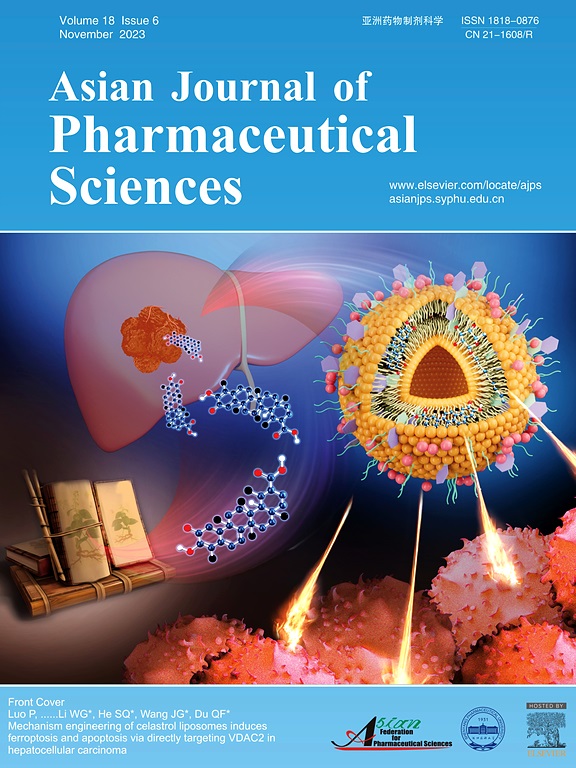通过靶向cd44纳米颗粒增强紫杉醇和阿兰妥内酯对结直肠癌的化学免疫治疗:STAT3信号通路调节方法
IF 10.7
1区 医学
Q1 PHARMACOLOGY & PHARMACY
引用次数: 0
摘要
化学免疫疗法有可能通过激活免疫原性细胞死亡(immunogenic cell death, ICD)来增强化疗和调节免疫抑制性肿瘤微环境,使其成为一种有前景的临床应用策略。Alantolactone (A)通过调节STAT3信号通路诱导更有效的ICD,以1:0.5 (P:A)的摩尔比增强紫杉醇(P)的抗癌功效。纳米给药系统可以将天然药物与常规化疗药物协同结合,从而增强多药化学免疫治疗。为了提高疏水药物的肿瘤靶向能力和生物利用度,以紫杉醇(PTX)和透明质酸(HA)为骨架对两亲性前药偶联物(HA-PTX)进行了化学修饰。基于这一概念,开发了靶向cd44的纳米药物(A@HAP NPs),用于在结直肠癌治疗中共同递送A和P,旨在实现基于毒性的协同化学免疫治疗。A@HAP NPs的均匀大小和高载药量,通过增强通透性和滞留效应以及ha介导的靶向作用,促进了其在肿瘤内的积累,为后续的协同治疗和免疫调节提供了坚实的基础。体外和体内研究表明,A@HAP NPs对肿瘤细胞具有强大的细胞毒性,同时还通过促进抗原呈递和诱导树突状细胞成熟来重塑免疫抑制的肿瘤微环境,从而为结直肠癌的化学免疫治疗提供了一种新的途径。本文章由计算机程序翻译,如有差异,请以英文原文为准。

Enhancing chemoimmunotherapy for colorectal cancer with paclitaxel and alantolactone via CD44-Targeted nanoparticles: A STAT3 signaling pathway modulation approach
Chemoimmunotherapy has the potential to enhance chemotherapy and modulate the immunosuppressive tumor microenvironment by activating immunogenic cell death (ICD), making it a promising strategy for clinical application. Alantolactone (A) was found to augment the anticancer efficacy of paclitaxel (P) at a molar ratio of 1:0.5 (P:A) through induction of more potent ICD via modulation of STAT3 signaling pathways. Nano drug delivery systems can synergistically combine natural drugs with conventional chemotherapeutic agents, thereby enhancing multi-drug chemoimmunotherapy. To improve tumor targeting ability and bioavailability of hydrophobic drugs, an amphiphilic prodrug conjugate (HA-PTX) was chemically modified with paclitaxel (PTX) and hyaluronic acid (HA) as a backbone. Based on this concept, CD44-targeted nanodrugs (A@HAP NPs) were developed for co-delivery of A and P in colorectal cancer treatment, aiming to achieve synergistic toxicity-based chemo-immunotherapy. The uniform size and high drug loading capacity of A@HAP NPs facilitated their accumulation within tumors through enhanced permeability and retention effect as well as HA-mediated targeting, providing a solid foundation for subsequent synergistic therapy and immunoregulation. In vitro and in vivo studies demonstrated that A@HAP NPs exhibited potent cytotoxicity against tumor cells while also remodeling the immune-suppressive tumor microenvironment by promoting antigen presentation and inducing dendritic cell maturation, thus offering a novel approach for colorectal cancer chemoimmunotherapy.
求助全文
通过发布文献求助,成功后即可免费获取论文全文。
去求助
来源期刊

Asian Journal of Pharmaceutical Sciences
Pharmacology, Toxicology and Pharmaceutics-Pharmaceutical Science
CiteScore
18.30
自引率
2.90%
发文量
11
审稿时长
14 days
期刊介绍:
The Asian Journal of Pharmaceutical Sciences (AJPS) serves as the official journal of the Asian Federation for Pharmaceutical Sciences (AFPS). Recognized by the Science Citation Index Expanded (SCIE), AJPS offers a platform for the reporting of advancements, production methodologies, technologies, initiatives, and the practical application of scientific knowledge in the field of pharmaceutics. The journal covers a wide range of topics including but not limited to controlled drug release systems, drug targeting, physical pharmacy, pharmacodynamics, pharmacokinetics, pharmacogenomics, biopharmaceutics, drug and prodrug design, pharmaceutical analysis, drug stability, quality control, pharmaceutical engineering, and material sciences.
 求助内容:
求助内容: 应助结果提醒方式:
应助结果提醒方式:


